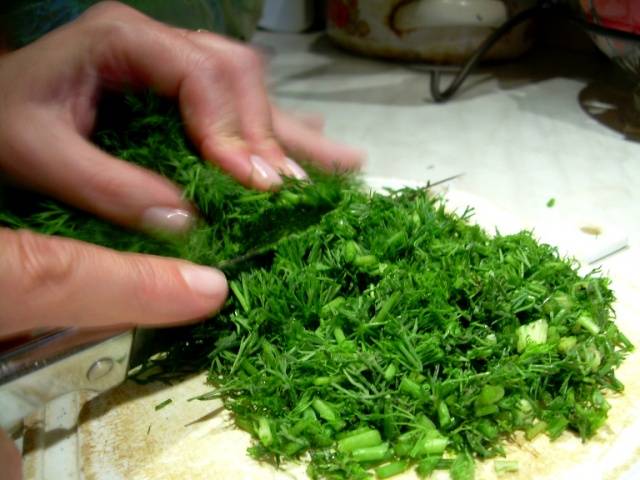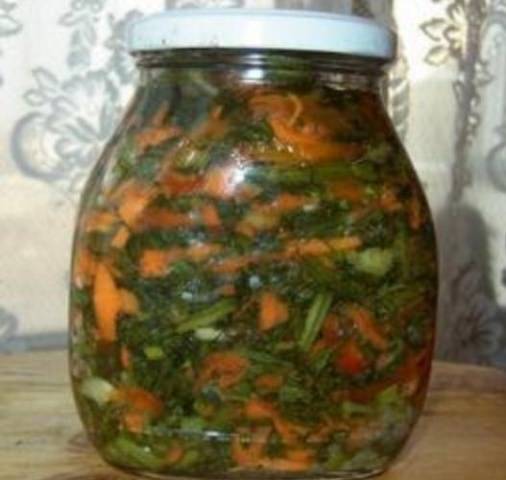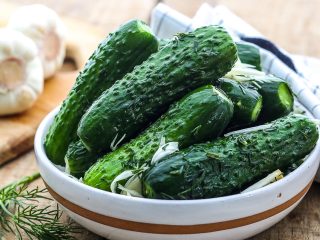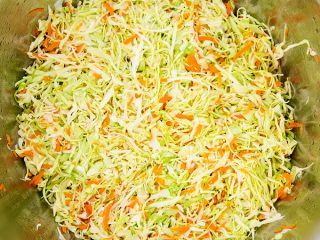Content
In summer, the garden is full of fresh, fragrant herbs. But even in winter I want to please you with homemade vitamins. How to be? There are many ways to prepare green leaves for the winter. We'll talk about the rules of pickling. It should be noted that salt saves up to 70% of nutrients and vitamins.
Often our readers, especially young housewives, are interested in how to pickle greens for the winter, what herbs and plants can be used, how long the preparations are stored. We will try to talk about all this in detail.
What greens are suitable for pickling?
Any herbs and leaves growing in the garden can be pickled at home for the winter. You can save in banks:
- dill and parsley;
- onion and garlic feathers;
- onion and garlic arrows;
- cilantro and celery;
- carrot and beet leaves;
- sorrel, arugula and other herbs.
Preparing for pickling
You need to cut off twigs and leaves from green plants immediately before salting. They are washed in several waters to remove the slightest grains of sand and insects. The herbs are left in the last water for two hours to remove the bitterness.After this, dill, parsley, celery, cilantro, other herbs and leaves are laid out in one layer on a clean towel to dry.
Do not cut the twigs and leaves too finely for pickling in jars for the winter; the pieces should be medium. Some sprigs of dill, parsley, celery or cilantro can be left whole. This is an excellent material for decorating dishes in winter.
You can harvest green leaves and herbs in different ways: use dry salting or pour brine over the preparation.
Place the prepared cuts into sterilized jars. The best container is 0.5 liters. You can close the jars with metal or nylon lids: in both cases it is stored perfectly.
How to pickle greens
After you have cut the branches and leaves and the jars are ready, start pickling.
Consider options with dry salt and brine.
Dry salting
Basically, when pickling herbs for the winter, the recipes are almost identical. In order for the green mass to retain all its qualities and not ferment, it is necessary to take 250 grams of salt per 1 kg.
And now about the principle itself:
- Harvested, washed, dried herbs and leaves are cut on a ceramic or wooden board and placed in a large basin. You can add salt to the total mass, mix well, and then put it in jars, compacting the layers.
- There is another option: pour dry herbs into the prepared container: a layer of greens - a layer of salt and so on to the top. Use a masher to compact the greens.
- Leave 1-2 jars in the room. During this time, dill, parsley or other herbs will settle. You can always add a new portion to the jar.
Many housewives film the process of salting greens. Let's see how it's done:
Salting in brine
If you want to always have practically fresh greens on hand in winter - carrot leaves, beets, onion and garlic arrows and various herbs, use brine for preparations.
How to pickle green twigs and leaves in brine, what do you need to know? There are two options for harvesting greens in brine:
- The prepared herbs and leaves (separately) are placed in an enamel pan, filled with water, salted to taste, and brought to a boil. Cook for no more than 5 minutes. The resulting mass is immediately poured into sterile jars and sealed.
- The greens are placed in containers, poured with boiling brine (salt to taste) and covered with metal lids.
Pickling recipe with brine
For a kilogram of herbs and green leaves you will need:
- water – 0.3 l;
- 8% vinegar - half a liter;
- salt – 30 grams;
- vegetable oil – 50 grams.
First, prepare the brine: after boiling the water, add vinegar and salt. This brine can be used to salt beet, radish and carrot tops, onions and garlic. You need to cut the twigs and leaves coarsely and put them directly into jars. Pour boiling liquid over greens, add oil. Immediately roll it up, turn it upside down and wrap it up. When the jars have cooled, store them in any cool place.
Assorted for the winter - recipe
Pickling greens for the winter is an interesting and exciting process that gives room for imagination. Many housewives combine several products.The result is a surprisingly tasty preparation, suitable for preparing first and second courses. This assortment is added in the last minutes of cooking.
We will need:
- parsley and dill leaves - one kilogram;
- leek - kilogram;
- celery leaves – 500 grams;
- carrots and ripe tomatoes (red and yellow can be used) - one kilogram;
- table salt – 1 kg.
The method of preparing salted greens with vegetables is simple:
- After thorough washing and drying, the greens are chopped.
- Grate the carrots on a coarse grater.
- Fleshy tomatoes are cut into strips.
- Mix with salt.
- Place the preparation in jars in layers: first greens, then carrots, again greens - tomatoes, until the container is full. Cover with a nylon lid or parchment paper. The preparation is stored in the refrigerator.
Salt sorrel
If you want to pamper your family with green cabbage soup and pies with delicious fillings in winter, pickle sorrel in jars. This will take a minimum of time, but you will be provided with vitamins.
To prepare, according to the recipe, you will need a kilogram of sorrel and 50 grams of table salt (not iodized).
Washed and dried sorrel can be chopped finely or coarsely, as you like. Place the mixture in a large container and add salt. You need to mix with your hands, but do not press on the leaves.
The mixture must stand for at least an hour for the juice to appear. If it's not enough, let it add more salt. After this, place the sorrel in sterile jars, pressing lightly. Cover with regular lids or roll up. Can be stored in a cellar or refrigerator.
As you can see, preparing sorrel for the winter in jars is not at all difficult.
Instead of a conclusion about the benefits
Pickling herbs and leaves for the winter is a great option:
- Firstly, you will be provided with fresh herbs all winter.
- Secondly, it retains almost one hundred percent of vitamins and nutrients.
- Thirdly, the taste and color of dill, parsley, celery and other herbs does not change.
- Fourthly, salt prevents the growth of bacteria that cause the fermentation process.
When cooking, if you use salted greens, you do not need to add salt - they have enough of it. So, go ahead and sing to the preparation of greens for the winter.
















